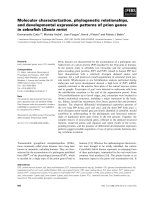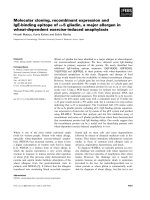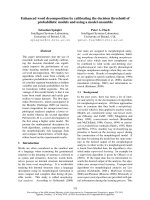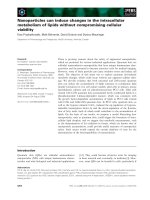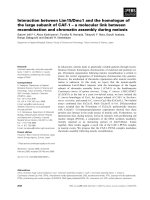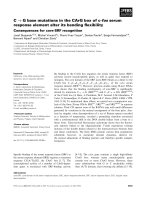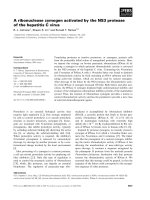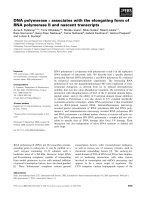Báo cáo khoa học: "Computational Lexical Semantics, Incrementality, and the So-called Punctuality of Events" potx
Bạn đang xem bản rút gọn của tài liệu. Xem và tải ngay bản đầy đủ của tài liệu tại đây (699.93 KB, 8 trang )
Computational Lexical Semantics, Incrementality, and the So-called
Punctuality of Events
Patrick CAUDAL
TALANA, UFRL, Universit6 Pads 7
2, place Jussieu
75251 Paris Cedex 05, France
caudal @ linguist.jussieu.fr
Abstract
The distinction between achievements and
accomplishments is known to be an
empirically important but subtle one. It is
argued here to depend on the atomicity
(rather than punctuality) of events, and to be
strongly related to incrementality (i.e., to
event-object mapping functions). A
computational treatment of incrementality
and atomicity is discussed in the paper, and
a number of related empirical problems
considered, notably lexical polysemy in verb
- argument relationships.
Introduction
Ever since Vendler (1957) introduced it, the so-
called punctuality of achievements has been the
object of many theoretical contests. After having
demonstrated that punctuality actually breaks up
into two, distinct notions, namely non-durativity
and atomicity, I will argue here for a
compositional semantic account of the latter. I
will show that (non-)atomicity interacts closely
with the notion of incrementality, as formulated
in Dowty (1991), and that this property of verbs
should be lexically encoded, although it is
subject both to semantics and pragmatics-driven
variations. I will finally discuss the formal
specifications an NLP system could use to make
predictions about atomicity and incrementality.
1. On Vendler's so-called achievements
Vendler (1957) defined achievements and
accomplishments as respectively punctual and
durative. He based his claims on two main tests,
noting that at <time expression> adverbials
combine with achievements but not
accomplishments, whereas finish combines with
accomplishments but not achievements :
(1 a) At what time did you reach the top ? At
noon sharp.
(lb) At what moment did you spot the plane ?
At 10:53 A.M.
(2a) *John finished leaving.
(2b) John finished drawing the circle.
Dowty (1986) and Moens and Steedman (1988)
decisively questioned the coherence of the class
of achievement verbs, arguing that not all of
them are non-durative. As noted above, Vendler
identifies punctual events through the
conjunction of the (positive) at and (negative)
finish tests. However, they do not always yield
comparable results :
(3a)
(3b)
(4a)
(4b)
Karpov beat Kasparov at 10.00 P.M.
*The Allies beat Germany at I0.00 P.M.
* Karpov finished beating Kasparov
The Allies finished beating Germany.
The at test fails to characterize (3b) as an
achievement because it is durative, whereas (3a)
passes this very test because it is non-durative.
On the contrary, the fnish test in (4) yields an
identical result for the beating of a chess player
and that of a whole nation. It appears thus that
the finish test does not indicate non-durativity,
contrary to the at test, which refuses durative
events, and that telic events such as (3b) fall
outside Vendler's classification, since they fail
both the finish test (unlike accomplishments)
.AND the at test (unlike achievements). Since it
497
is desirable that achievements should include
events such as (3b), durativity should not be
considered as a necessary property of
achievements. The salient common point
between (3a) and (3b) is that both events lack
proper subparts, i.e., are atomic. Atomicity
should thus be regarded as the defining property
of achievements ; it can be tested with finish.
2. Atomicity as a semantic issue
Many authors, including Verkuyl (1993) and
Jackendoff (1996), have denied atomicity any
semantic content, and have argued that it is a
pragmatic category. I do not intend to claim here
that atomicity is not subject to pragmatic
constraints. The following examples identify one
such constraint, i.e., the relative size of
arguments of verbs of consumption :
(5a)
(Sb)
??John finished eating the raspberry.
The bird finished eating the raspberry.
(5a) suggests that raspberries are so small with
respect to a human 'eater' that eat denotes an
atomic event. But the same does not hold true of
birds (cf. (5b)). No attention will be paid to this
kind of pragmatic constraint in this paper.
Yet I will demonstrate here that atomicity does
possess a semantic content, and that therefore it
can be regarded as an aspectual category.
Consider the following examples ~ :
(6a) *The soldierfinished crossing the border.
(6b) The soldiers finished crossing the border.
(7a) *John finished slamming the door open.
(7b) John finished slamming the doors open.
The plural NPs the soldiers and the doors
possess proper subparts, along which the
crossing and slamming events in (6b) and (7b)
are measured, making those events non-atomic
(there are several distinct subevents of one door
being slammed, and of one soldier crossing the
border) ; compare with the atomic (6a) and (7a),
where those very NPs are singular. The variation
in noun quantification being a semantic one,
1 Similar examples were proposed by Declerck
(1979), but were discussed in terms of durativity, and
not of atomicity.
atomicity should clearly receive some form of
semantic content. Moreover, it should be noted
that atomic events are not compatible with the
progressive perfect, whereas non-atomic ones
freely combine with it s :
(8a) *The soldier has been crossing the
border.
(OK with iterative, non-atomic reading)
(8b) The soldiers have been crossing the
border.
Those facts support a semantic view of
atomicity 3.
3. Towards a semantic account : (non-)
atomicity and incrementality
The above data suggests an interesting solution
to this puzzle : atomicity seems to be related to
the notion of inerementality, as formulated in
Dowty (1991) (see also graduality in Krifka
1992). To my knowledge, the concept of
incrementality (originally proposed to account
for the telicity of events) has never been
discussed in the light of that of atomicity,
although this is an obvious thing to do, both
concepts being about the present or absence of
subevents in the internal structure of events. I
will undertake to bridge this gap here.
3.1 Incrementality and delimiting
arguments
Dowty defines incrementality as a property of
verbs whose development can be measured
along the inner structure of one of their
arguments (which he calls incremental theme) •
(9) John drank a glass of beer.
In (9), the development of the drinking event can
be measured along the subparts of the glass of
beer. Each subpart of the incremental theme
argument is mapped onto a subpart of the
2 Complementary tests such as the different readings
of in etc. will not be studied here for want of space.
3 Caudal (1998) discusses at length related examples
involving collection-referring nouns (e.g., orchestra
or regiment), and shows that they behave similarly,
cf. The regiment finished crossing the border.
498
corresponding event (a fact which Dowty (1991)
and Krifka (1992) refers to as event-object
homomorphism). Dowty (1991) rejects
ostensibly the possibility to treat as incremental
themes the patient arguments of so-called
punctual (i.e., achievement) verbs, such as slam
open. According to him, incremental themes
should be able to undergo a gradual change of
state 4. Unfortunately, Dowty does not consider
examples such as (7b), which exhibit an
incremental behaviour although they include this
very kind of patient argument. I will therefore
reject Dowty's objection, and regard (7b) as
incremental.
It follows naturally from the above definition
that incrementality entails non-atomicity: it
implies that a situation's development possesses
proper subparts, and therefore that it is non-
atomic. But does non-atomicity entail
incrementality, conversely ? I.e., are those two
notions equivalent ? If not, how should they be
connected ? In order to answer those questions
in the following sections, I will make use of a
rough feature-based notation: [+/-ATM] will
express atomicity/non-atomicity, and [+/-INC]
incrementality/non-incrementality.
3.2 Non-atomicity with incrementality
I will call delimiting arguments the arguments of
a verb serving as 'measures' (or 'odometers') for
the corresponding event (e.g. the internal
arguments of drink or slam open). It should be
noted that this term is broader than that of
incremental theme, since it includes e.g., patient
arguments of so-called punctual verbs, which
Dowty refused to regard as incremental themes.
For the sake of simplicity, I will focus in this
paper exclusively on internal delimiting
arguments :
(lOa)
(lOb)
(lla)
(llb)
John finished eating his apple.
John finished eating his apples.
*John finished throwing his stone.
John finished throwing his stones.
4 Cf. Dowty (1991:568): Many traditional
Themes are not Incremental Themes. Many
achievement verbs entail a definite change of state in
one of their arguments but never in distinguishable
separate stages, i.e. subevents.
(10) shows that eat can be [-ATM],[+INC] both
with a definite singular and plural delimiting
argument, whereas (11) shows that throw can be
[-ATM],[+INC] only with a definite plural
delimiting argument. The development of eating
his apple is measured in (10a) along the quantity
of apple remaining to eat, whereas that of
throwing his stones in (lib) is measured along
the successive individual stones being thrown
away. I will extend the notion of incrementality
to this latter kind of event-object mapping.
Under this view, incrementality arises from
delimiting arguments, and not only fore
incremental themes. However, I will distinguish
two types of incrementality, thereby preserving a
distinction between Dowty's incrementality and
the extension I proposed. I will call
m-incrementality (for quantity of matter-
incrementali~) the type of incrementality
exhibited by (10a) and i-incrementality (for
individual-inerementalitv) that exhibited by
(lib). At least two classes of verbs can be
distinguished in this respect" verbs like eat are
capable of m-incrementality, i.e., incrementality
with individual-referring delimiting arguments
(they have an incremental themes in the sense of
Dowty), whereas verbs like throw are only
capable of i-incrementality, i.e., incrementality
with collection-referring delimiting arguments
(they lack an incremental theme in the sense of
Dowty). Of course, non-atomicity can follow
from either i or m-incrementality.
Another type of incremental non-atomic events
can be found in path-movement verbs :
(12)
Mary walked the Appalachian trail.
(Tenny 1994)
The development of the walking event can be
measured along the explicit path argument the
Appalachian trail in (12). It is therefore
[-ATM],[+INC]. White (1994) proposed a
generalized path-based incremental theme role
to account for the semantic behaviour of both
patient and path delimiting arguments, fairly
akin to the present one, since it crucially relies
on a similar individual / quantity of matter
distinction. One could conclude at this point that
499
the present account of incrementality is
sufficient to predict (non-)atomicity, and that
non-atomicity and incrementality are equivalent
notions. If that is right, then non-incremental
events should be non-atomic. However, I will
show in 3.3 that it is not the case.
3.3 Non-atomicity without inerementality
Some non-atomic events lack a delimiting
argument, so that the type of non-atomicity
involved seems unrelated to incrementality :
(13) John finished digesting his pudding.
(14) John finished cooking the chicken.
(15) John finished registering his son at the
university.
Contrary to (10) and (llb) , neither (13), (14)
nor (15) are (necessarily) measured along the
subparts of their patient arguments. (13) and
(14) are rather measured along the state of the
latter, which vary as time passes. In this sense,
his pudding and the chicken do not behave like
delimiting arguments, and those non-atomic
situations are non-incremental ([-ATM],[-INC]).
Some sort of non-argumental odometer seems to
be required. In the case of (13) and (14), digest
and cook receive a scalar result state, i.e., one
that varies as time passes: John's chicken
becomes (as a whole) closer to being (finally)
cooked as time passes in (14), and John's
pudding gradually turns (as a whole, and not bit
by bit) into nutriments inside his stomach in (13)
(see Caudal (1999a/b) for a treatment of such
data). I will refer to this kind of incremental-like
reading as scalarity. If one considers (15), things
are somewhat different, as there exists some sort
of predetermined series of stages through which
one should pass in order to register at the
university: John's son is closer and closer to
being registered at the university as his father
goes through them. I will refer to this kind of
data as gradual scenarios.
I will turn now to the computational treatment of
incremental non-atomic events (section 4),
before suggesting some ways of accounting for
non-incremental non-atomic ones (section 5).
4. A formal, computational treatment
of incremental non-atomic events
A formal and computational treatment of
incremental non-atomic events will be
formulated here, relying on model-theoretic
logics and on the Generative Lexicon framework
(GL henceforth ; see Pustejovsky (1995) for an
introduction). I will first discuss a few
theoretical notions related to the internal
structure of objects and events, in order to
formalize m and i-incrementality. I will leave
aside the treatment of incremental path-
arguments, referring the interested reader to
White (1994).
4.1 Internal structure of objects
and
events : Link's
part-of
operators
Following Link (1983), I will oppose individuals
(i.e., the denotata of nouns referring to
individual entities) and collections (i.e., the
denotata of definite plural NPs, collectives, etc. ;
see Caudal (1998a)). Let A be the domain of
entities (events or objects), structured as a semi-
lattice. Let individual_.part_of be a partial order
relation on individual entities (henceforth i-part
or <i), connecting an individual to the collection
it belongs to. Let Idi be the join operation on
individuals and collections, y a collection and x
an individual, such that x is an i-part of y. The
definition of the meronymic operator <i was
formulated by Link as follows :
(16) Vx,y [x <i Y > x Ui y = y]
Following again G. Link, I will define similarly
a partial order relation on non-individual parts,
m-part (or -<m), which connects an individual
and its non-individual parts (e.g. a slab of stone
to a rock). All those operators will apply both to
events and objects in the model (events being
reified). As a consequence, collection-referring
NPs as well as i-incremental events are endowed
with i-parts, whereas individual-referring NPs
and m-incremental events possess m-parts.
I will argue that incrementality depends both on
lexical information and structural composition.
Whether events will receive (or not) an
incremental reading is determined at the
structural level, depending on the interaction of
500
a verb with its delimiting arguments (modulo
pragmatic constraints). I will now describe the
lexical component of this compositional
procedure.
4.2 Encoding incrementality within the
Generative Lexicon framework
I will propose here to encode lexically whether
verbs are capable of m-incrementality or
i-incrementality. It should be noted that although
the ability to exhibit m-incrementality seems to
be a constant lexical property, any potentially
incremental verb can receive an i-incremental
reading (but recall that not all verbs can be read
incrementally). In the spirit of Krifka's object-
event mapping functions (see K_rifka 1992), I
will assume an i-inc aspectual semantic role
function that relates the i-parts of an argument
to the development of an event (causing it to
become i-incremental with an appropriate
delimiting argument), and a m-inc function that
relates the m-parts of an argument to the
development of an event (causing it to become
m-incremental with an appropriate delimiting
argument). The following event/object mapping
predicate MAP-I (applying only to i-inc
aspectual roles) can be derived from Krifka's
MAP-O/E (mapping to objects/events)
predicates (see Krifka 1992:39) by replacing his
standard partial order operator with
<i :
(17) MAP-I :
VR[MAP-I(R) ~ MAP-Ei (R) ^ MAP-Oi (R)]
VR[MAP-Ei (R) ~-~ Ve,x,x' [R(e,x) ^ x'<i x >
He' [e' <i e ^ R(e',x')] ] ]
VR[MAP-Oi (R) < > Ve,e',x [R(e,x) ^ e'<i e >
qx' [ x'<i x ^ R(e',x')] ] ]
A similar formulation can be given for
m-incrementality ; replace
<i
with -<m in (17).
Thus, by combining Link's part-of operators
with Krifka's event-object mapping functions,
atomicity construal functions can be formulated.
Finally, GL will provide us with the proper
computational lexical machinery in which to
insert those functions : ! will propose to encode
those aspectual roles within the argument
structure (ARGSTR) feature in GL, by making
them bear directly on the relevant argument
position. The following entries for eat and throw
illustrate such an encoding for internal
arguments (again, external arguments are left
aside for the sake of simplicity) :
throw
:ARGSTR =
EVENTSTR
=
QUALIA =
eat
ARGSTR =
EVENTSTR
=
QUALIA =
~GI = x-'ind
G2 y: Ind, i-inc (y, el)
~
i = e~:throw_a~t
2 e2 : Binary_RStag~
AGENTIVE = throw_act(ez,x,y)
~A~
G1 =
x=ind
G2 y: ind, m-inc (y, ex)
2 e2 :
binary-RStage~
AGENTIVE = eat act(ex,x,y)
=/i-inc (x, e) indicates that the internal
structures of subevent e and argument x are
related by an homorphic mapping. If x possesses
proper subparts, then e will be incremental ; the
whole point remains that incrementality is
lexically licensed but structurally construed. The
Binary_RStage subevent refers to the complex
result state (Result Stage ; cf. Caudal 1999b)
attached to a transition such as eat. Its binary
structure expresses a change-of-state. I will now
consider some difficulties related to lexical
polysemy and verb-argument relationships.
4.3 Lexical polysemy and incrementality
I assume here that the incrementality functions
i-inc / m-inc are lexically specified. Yet the full
story is a lot more complicated. Much data
suggests that those functions can be modified or
determined (when they are lexically
underspecified) in context. An overview of a
number of problems and a tentative treatment
within GL will be proposed here.
4.3.1 Co-composition and inerementality
The machinery proposed above is not sufficient
to account for subtle cases of lexical polysemy
originating in the interaction between the verb
and its arguments. Some data would be best
treated in terms of co-compostion within GL 5 :
5 Roughly, co-composition refers to cases of lexical
polysemy in which a lexical item receives a 'new'
501
(18a)
(18b)
*Le moteur acheva de produire un bruit
dtrange.
The engine finished emitting a strange
noise.
Yannig acheva de produire son article.
Yannig finished writing his paper.
The French verb produire yields an
i-incremental reading in (18a), vs. a
m-incremental reading in (18b). Arguably,
produire means 'to cause to come into
existence', and therefore makes use of the
content of the AGENTIVE qualia role (i.e., the
qualia role indicating how a type is brought into
existence) of its internal argument to determine
the corresponding 'creation' event. The
AGENTIVE roles of bruit and article can be
represented as follows :
(19) Fbrult ARGI = sound IIARGSTR =
~
UALIA AGENT IVE = |
~4 t_sound (e, y, x)J
(20)
IAR rticle
GSTR = ARGI = x : info I
UALIA= AGENTIVE = write(e,y,x)~
By virtue of the co-composition operation
involving events specified in the AGENTIVE of
bruit and article, produire interacts differently
with its internal argument, and receives different
event structures. The e~_ e_so~-aa (e, y, z) event
in (19) comes along an i-inc function mapping
the internal argument x onto e, while the
wriee(e,y,x) event in (20) comes along an
, inc function mapping z onto e. In fact, the
whole event structure of those AGENTIVE roles
together with their incrementality functions
override those lexically specified by default for
produire.
Another limit of GL until recent work (cf. Asher
and Pustejovsky 1999) was its inability to
construe more versatile qualia role information.
Consider the following case of co-composition :
sense (i.e., one not considered to be lexicalized)
through the contribution of another lexical item with
which it combines. See Pustejovsky (1995).
(2 la) Yannigfinished hiding the bike.
(2 lb) * Yannigfinished hiding the truth.
Hide x arguably means 'to remove x from
accessibility', and obviously the notion of
'accessibility' diverges when x is a physical
object (21a) or a proposition (21b). This kind of
phenomenological information might be
encoded in the FORMAL role for the
corresponding super-types and triggered in this
context, but a detailed implementation still has
to be worked out. See Asher and Pustejovsky
(1999) for a discussion of such issues.
4.3.2 Other cases of polysemy
Last but not least, many cases of apparent
polysemy in the incrementality functions
actually arise from the coercion of affected
arguments :
(22a) Yannig a fini de ranger sa chambre.
Yannig finished tidying up his room.
(22b)
* Yannig a fini de ranger son livre.
(gradual scenarios being left aside)
Yannig finished putting away his book.
Ranger receives an incremental reading with
chambre in (22a), and no incremental reading in
(22b), so that it seems to be properly neither
i-incremental nor m-incremental. The way out of
this puzzle is the following : ranger is lexically
encoded as capable of i-incrementality but not of
m-incrementality, and the aspectual polysemy of
ranger sa chambre originates in the polysemy of
chambre. Although there is no question that
chambre normally refers to an individual, its
meaning is coerced into a collective one in
(22a). More precisely, chambre is coerced from
an individual real estate sense
(immovable_phys obj) to a collection sense
involving the individual objects possibly
enclosed within a room (movable_phys_obj),
since only the latter is compatible with ranger.
One way of accounting for such coercions
within GL would be to associate with the
CONST qualia role of chambre such a collection
of instances of the movable_phys__obj type, the
CONST role describing the meronymic
constitution of a type.
502
In fact, the ability to trigger this very kind of
coercion seems to be a general property of verbs
addressing their arguments through their
FORMAL role (i.e., requiring natural types -
centrally defined through their CONST and
FORMAL - and not functional types - centrally
defined through their AGENTIVE and TELIC ;
see Pustejovsky 1999). Such verbs are usually
able to access their arguments' semantics as
individuals through their FORMAL role, and as
collections of individuals through their CONST
role, if the FORMAL individual does not meet
the selectional restrictions imposed by the verb,
or other semantic constraints. See Caudal (1998)
for detailed evidence of this, and for a tentative
solution within GL to the problems raised by the
polysemy of collective nouns (e.g., regiment,
police and forest), which exhibit a similar
behaviour, i.e., can either refer to individuals or
to collections. Finally, it should be noted that
homeomeronymic nouns (i.e., whose parts and
whole refer to the same lexical type, e.g. estate
or property seen as land surfaces, or quantity of
matter nouns, such as gold or milk ; see Winston
et al, (1987)) offer other interesting properties
w.r.t, to incrementality/atomicity. I will not
discuss them here for want of space.
To put it in a nutshell, even prima facie
individual-referring nouns such as chambre can
behave like collection-referring ones under
certain circumstances, making i-incremental
readings of normally atomic events possible. Let
us move now to some concluding remarks about
non-incremental non-atomic events.
5. On the formal treatment of non-
incremental non-atomic events
I have shown above that the notion of
incrementality fell short of explaining the non-
atomicity of (13), (14), and (15). I will suggest
here a solution based on an extended conception
of result states.
The non-incremental, non-atomic events
discussed in 3.3 seem to fall into at least two
distinct subclasses : scalar events (cf. (13)/(14))
vs. "gradual scenario" events (cf. (15)). I will
focus on the former class, the latter class
originating clearly in a pragmatic phenomenon 6.
It should be noted that many resultative
constructions (e.g., pound the metal flat; see
Levin and Rappaport 1995) also receive scalar
readings, making the phenomenon a fairly
widespread one.
\
It is a fact that the notions of affectedness and
incrementality / event-object mapping do not
apply to scalar events. Affectedness indicates
that an argument undergoes an incremental (cf.
eat) or a definite change of state (cf. throw), and
not a gradual bu___!t total one, as in the case of
scalar verbs (their delimiting arguments are
gradually changing as a whole, and not bit by
bit). (14) is telic and non-atomic because the
chicken goes through successive states of
'cookedness' (i.e., result states) before reaching
a final state, and not because of some event-
object mapping function in the spirit of Krifka
(1992). Therefore, the telicity of scalar events
can only be explained by reference to this scalar
change of state, which entails itself a scalar
result state. Encoding a richer information about
result states in the lexical entries of such verbs,
as proposed in Caudal (1999a/b), would allow us
to account elegantly for this kind of non-atomic,
non-incremental, telic readings of events.
This new conception of result states provide us
with a unified account 7 of (non)-atomicity,
incrementality and telicity - a result which
generalized paths cannot achieve for reasons
exposed above, and others not discussed here.
Indeed, even the non-incremental, non-atomic
events studied in 3.3 (except (15), but then again
this is a pragmatic issue) can also be accounted
for in this manner, and path-argument verbs can
also be analysed in terms of result states if
changes of location undergone by arguments are
treated as changes-of-state.
6 Note that contrary to scalar events and incremental
events, "gradual scenarios" do not combine with the
progressive perfect, of. *John has been registering his
son at the university. This fact suggests that they
should be set apart from other non-atomic events, and
possibly receive subevents of a different kind.
7 See Caudal (1999b), where incremental vs. scalar
RStages are introduced.
503
Conclusion
It has been demonstrated in this paper that the
so-called punctuality of
achievements
should be
reduced to the notion of
atomicity.
Formal
means to calculate it within an NLP system have
been discussed; see White (1994) for a
computational implementation of related
interest, in a similar spirit. The machinery
exposed above can be used to predict whether an
event should be considered as an
accomplishment
(non-atomic event; possesses
subevents) or an
achievement
(atomic event;
lacks any subevent).
The above developments revealed that
(non-)atomicity is at least partly amenable to a
compositional semantic procedure, and does not
fall altogether under the scope of pragmatics. It
has been shown to be directly related to
incrementality in many cases, though not in all
cases. In order to construe incremental non-
atomic events, I proposed to encode
m-incrementality vs. i-incrementality in the
lexicon, before discussing the
accessibility
of the
internal structure of delimiting argument NPs ; I
suggested a solution to the problems raised by
the polysemous internal structure of certain
nouns. Finally, a tentative result-state based
account of non-incremental non-atomic events
has been proposed. I even claimed that it can
explain all types of non-atomicity and even
incrementality in a unified way, and therefore
might surpass all the existing accounts of event
structure.
References
Asher, N. and J. Pustejovsky (1999) The
Metaphysics of Words in Context. Ms., Brandeis
University.
Caudal, P. (1998) Using Complex Lexical Types to
Model the Polysemy of Collective Nouns within the
Generative Lexicon.
Proceedings of DEXA98,
IEEE Computer Society, Los Alamitos, pp. 154-
160.
Caudal, P. (1999a) Resultativity in French - A Study
in Contrastive Linguistics. Paper presented at the
29 t~ Linguistic Symposium on Romance
Languages, University of Michigan, Ann Arbor,
MI, April.
Caudal, P. (1999b) Result Stages and the Lexicon :
The Proper Treatment of Event Structure.
Proceedings of the 9 th Conference of the European
Chapter of the Association for Computational
Linguistics, Bergen, Norway, June.
Declerck, R. (1979). Aspect and the
bounded/unbounded (telic/atelic) distinction.
Linguistics
17, pp. 761-794.
Dowty, D. (1986) The Effects of Aspectual Class on
the Temporal Structure of Discourse : Semantics or
Pragmatics ? Linguistics and Philosophy, 9, pp. 37-
61.
Dowty, D. (1991) Thematic Proto-Roles and
Argument Selection. Languages 67/3, pp. 547-619.
Jackendoff, R. (1996) The Proper Treatment of
Measuring Out, Telicity and Perhaps Event
Quantification in English. Natural Language and
Linguistic Theory, 14, pp. 305-354.
Krifka, M. (1992) Thematic Relations as Links
between Nominal Reference and Temporal
Constitution. In
Lexical Matters,
I. Sag and A.
Szabolsci, eds., CSLI, Stanford, CA, pp. 29-53.
Levin, B. and M. Rappaport Hovav (1995)
Unaccusativity: At the Syntax - Lexical Semantics
Interface.
MIT Press, Cambridge, MA.
Link, G. (1983) The Logical Analysis of Plurals and
Mass Terms. in R. Baiierle, C. Schwarze and A.
von Stechow (eds.),
Meaning, Use and
Interpretation of Language,
Walter de Gruyter,
Berlin, pp. 302-323.
Moens, M. and M. Steedman (1988) Temporal
Ontology and Temporal Reference. Computational
Linguistics, 14/2, pp.15-28.
Pustejovsky, J. (1995)
The Generative Lexicon.
MIT
Press, Cambridge, MA.
Pustejovsky, J. (1999) Decomposition and Type
Construction. Ms., Brandeis University.
Tenny, C. (1994)
Aspectual Roles and the Syntax-
Semantics Interface,
Kluwer, Dordrecht.
Vendler, Z. (1957) Verbs and Times. The
Philosophical Review, 66, pp. 143-160.
Verkuyl, H. (1993)
A Theory of Aspectuality.
Cambridge University Press, Cambridge.
Winston, M.E., R. Chaffin and D. Hermann (1987)
A taxonomy of part-whole relations. Cognitive
Science, 11, pp. 417-444.
White, M. (1994)
A Computational Approach to
Aspectual Composition.
Unpublished Ph.D.
dissertation, Institute for Research in Cognitive
Science, University of Pennsylvania, Philadelphia.
Acknowledgements
Many thanks to James Pustejovsky for the very
fruitful discussions we had about incrementality.
504

